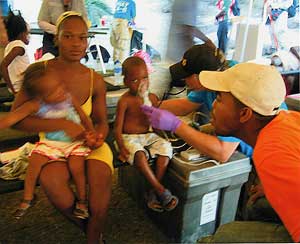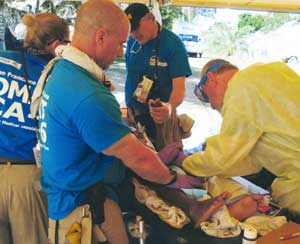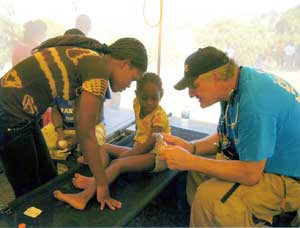Respiratory Care Cares About Haiti:
Members and Vendors Share Their Stories
February 15, 2010
AARC members Alan Roth, RRT-NPS, FAARC, Francis Almonor, BS, RRT, Frank Caminita, RRT, and Bob Stafford, RRT recently shared very different but equally heart wrenching stories about trips they made into Haiti shortly after the country was devastated by a massive earthquake in January.
Roth went as a member of the California Six (CA-6) Disaster Medical Assistance Team (DMAT) out of Santa Clara, CA. Almonor, who is a native of Haiti now living in North Carolina, traveled to his homeland to find his father, nephews, and sister. Caminita and his colleague, Robert Dutruch, RRT, went to help their company, Dräger, set up donated ventilators at a field hospital established in Port-au-Prince by the University of Miami. And Stafford traveled to the country with a team put together by the AFT Union out of Vermont.
Read Alan’s story | Read Francis’ story | Read Frank’s story | Read Bob’s story
You can also learn what our Corporate Partners and other respiratory vendors are doing to assist the recovery efforts.
Close story and return to page
On the Ground with the CA-6 DMAT
—Alan Roth, RRT-NPS, FAARC
The automated response system notified me of the deployment at 2:36 p.m., on Wednesday, Jan. 13. I confirmed the message and awaited orders. Since January was our on-call month, I already had my “ready bag” and my “24 hour bag,” which contains all the equipment and supplies I need to begin working immediately in any environment, in my car. I changed into my uniform and was ready to go.
Members of our team are required to be available to leave from either headquarters or the airport within four hours of getting the call. For me, this meant an almost immediate deployment because I am about 100 miles from the airport or headquarters in Modesto, CA.
I left a meeting, notified my boss and my assistant manager with instructions, and departed. I called my wife, as she had just returned from the Philippines, and told her to call the kids.
Utter devastation
Upon arrival in Atlanta, the team assembled and was briefed as to our mission. We were given anti-malaria drugs and a typhoid inoculation. Upon our arrival in Port-au-Prince we were assigned by the embassy to the Forward Operating Base (FOB) in Petion-Ville, an area in southwest Port-au-Prince.
Our drive from the airport — escorted by UN forces and the US military — revealed utter devastation in all directions. The area we were assigned to had between 30,000 and 50,000 homeless people living at the base of a ravine, as all structures were gone or uninhabitable.
Our team consisted of 38 medical professionals. I was the only respiratory therapist deployed. My primary medical responsibility was to serve as an RT in an expanded role of triage and assessment. Our hospital tent was divided into three treatment areas. Green was for ambulatory and triage, yellow was for the seriously wounded or sick, and red was for critical patients. We had 19 beds in total.
We evaluated and treated 400 to 600 patients a day who were suffering from a wide variety of injuries and illnesses, including traumatic amputations, open compound fractures, complicating conditions of pneumonia, asthma, bronchiolitis, open abscessed wounds, dehydration, burns, and sepsis. We delivered babies, and I worked stabilizing the newborns.
A major function for me was monitoring the respiratory status of individuals who needed conscious sedation for major procedures, as we could not deliver general anesthesia. We only had a limited supply of oxygen in the cache, so using my handheld pulse oximeter and keeping my hand on the person’s chest to monitor respirations was critical. We only had one nebulizer compressor, but we did have MDIs. I fashioned mini spacers out of used water bottles to treat even the smallest children.
Challenging conditions
Our team was joined by elements of DMAT teams from New Jersey, New Mexico, and Massachusetts. Six strike teams of three to five medical practitioners would go down from our base camp into the people and identify patients to be brought back up to us. They were escorted by the 82nd Airborne for Force Protection. Many times, I would give the young children a breathing treatment, followed by 15 cc of electrolyte solution given by needleless syringe. If the child could keep the fluid down, we would give liquid antibiotics the same way; if not, then by injection.
Each member of our team also had a secondary function. Mine was Logistics. This meant going to the airport to uncrate supplies that were needed to continue operating. We would repack the supplies into sizes that individuals could carry in this terrain.
We slept on the ground outside, with our ground cover and sleeping bags. Aftershocks were always present. We did have a 6.2 second earthquake that was pretty scary. The temperature in our tent hospital was around 110 degrees, with a heat index in the dangerous level. We were required to drink 0.5 liters of water every 20 to 30 minutes. We kept track of our water use using wooden beads on our lapels. This way all team members could see at a glance who needed a hydration break. This device was invented by one of our team members, Mark Weston, RN. It saved us from serious complications of the heat.
We ate when we could grab some time. Meals consisted of the Humanitarian Food Package, a 2,000 calorie, high protein, high fat meal similar to the military’s Meals Ready to Eat, or MREs. Unfortunately, they did not include coffee, but luckily my craving went away after three days.
“USA, USA”
We worked from first light at around 6 a.m. to dusk and sometimes beyond to see all the patients who had made it to our tent. We also had a helicopter landing zone so that a helicopter could bring in water and food, and when available, transport our most critical patients to the USN hospital ship, the Comfort, which was docked off shore.
Every person we met, treated, and spoke to (with the assistance of Creole translators from the US Public Health Service and CDC) was warm, thankful, and appreciative. We saw no violence or disturbances. They even chanted “USA, USA.” All the patients were very stoic, even in the face of despair. All the children we treated had some extended family member or neighbor to care for them. We gave them hope for another day. With limited resources, we were not able to treat the patients who had malaria, tuberculosis, AIDS, or PCP pneumonia.
I have been a therapist for 30 years, and over the past 15 years have worked overseas on missions in Cambodia, China, Guatemala, the Dominican Republic, and the Philippines, and it is always the children who you help or cannot help that stay vivid in your mind. The bringing of new life into the world is amazing, and that first cry is indescribable. We may have known only a few words in Creole, but the unspoken words on the faces of the Haitian people, and their spirit, will be with me the rest of my life.
When you really need an RT…
We were deployed for two weeks, then rotated back out to the world. When I returned to California, I went back to work and resumed my “normal” day-to-day. We are on call again in April, ready to serve those who need us.
Of the five teams I had contact with, none included RTs. I do not know if any of our replacements had team members who were deployed as therapists. One of the medical professionals told me she had never met a therapist like me. I explained that I was not unique in my skill set or dedication, and that many people were just as skilled as I was in the profession. As we left the country, she turned to me and said, “You never know you need a therapist, until you really need a therapist.”
We did some amazing things with a group of dedicated professionals who gave it their all (even to the point of exhaustion) to make a difference. We do not know how the ripple effect of the people we saved will extend into the future. But we need to hold on to the possibility that they will do good things, otherwise the knowledge of at least 112,000 known dead and the estimated two to three times that buried in the rubble would be too much to bear.
I am proud to be a member of this team and a respiratory therapist. People may never know who I was or what I did. But whether I was singing lullabies to babies or comforting people who knew someone cared, I know I made a difference in their lives. I will also be haunted by the ones I could not save.
Close story and return to page
Close story and return to page
Family First: Going Home to Rescue My Sister
—Francis Almonor, CRT
I came to the US in 1989 after political turmoil forced me to give up my premed studies at the only state university in Port-Au-Prince, Haiti. Two days after landing in New York, I found a job as a dishwasher at a restaurant in Long Island. Eventually, I obtained my green card and joined the Army Reserve to help pay for my college education.

Francis Almonor and his sister, during
happier times.
After my military training I enrolled in the respiratory program at Nassau Community College at the advice of a friend who had just graduated from the same school as a respiratory therapist. Since my early childhood in Haiti I knew I wanted to be doctor or do something in the health field because of frequent visits to the hospital for a friend with an enlarged heart. I did not have the support or the funds to afford medical school in the States. Today I’m a therapist at Wake Forest University Baptist Medical Center in Winston-Salem, NC, and Moses H. Cone Memorial Hospital in nearby Greensboro.
World turned upside down
When I first heard about the earthquake, I thought it was something insignificant, until my brother told me it was being covered on CNN and he had just spoken to my sister in Haiti and she said her nursing school had collapsed on her. At this moment my world just turned upside down. I started to imagine the worst for her and her two children, my dad, many cousins, and close friends.
My wife rushed me home immediately after that phone call. When I arrived home I started calling everybody on my phone list in Haiti, but I was not able to communicate with a single soul — not even my sister, whom my brother in New York had just miraculously spoken to minutes earlier. For about three agonizing days we were without any news of love ones. I was glued to the TV and the Internet for any news from Haiti. After seeing the magnitude of the devastation, I made the decision to go to Haiti to help in any capacity I could.
The third night after the earthquake we received news that my dad and my nephews were okay but my sister was in critical condition at a hospital in the Dominican Republic. It was my sister’s oldest son who managed to call my mother in New York to finally give us some information from Haiti. Someone in New York called my wife, who in turn contacted me with the latest news.
Worst fears realized
On my way to the Dominican Republic I was worried sick about what I would find when I reached the hospital. Unfortunately, when I finally saw her in the hallway of that overcrowded hospital, my worst fears materialized. She looked scared and still in shock, and was starring at me, not knowing who I was. She had a cut above her right eye, a deep untreated wound on her lower back, and no feeling from the waist down.
It was extremely hot, and I was desperately trying to keep her cool and chasing flies away with a newspaper. Both her arms were swollen with infiltrated normal saline IV. A lot of people were screaming in pain, and most had trouble communicating with the overwhelmed staff, who only spoke Spanish.
After I left the hospital I called my wife and my brothers with an urgent message: we have to get her to Florida or she will die here. I then went straight to the US consulate in the Dominican Republic to request a visa that would allow her to come to the US.
The US consul told me to come back in two days with her passport. The next day, at 4AM, I was in a van to Port-Au-Prince to retrieve her passport. Nine hours later, after travelling over numerous potholes and gravel roads, I was in Haiti.
I saw a country completely destroyed, as if a nuclear bomb was dropped and leveled everything. The stench of dead bodies was everywhere, lots of people were standing around collapsed houses, lots of aid trucks and military vehicles were in the streets. Complete chaos.
Real trouble starts
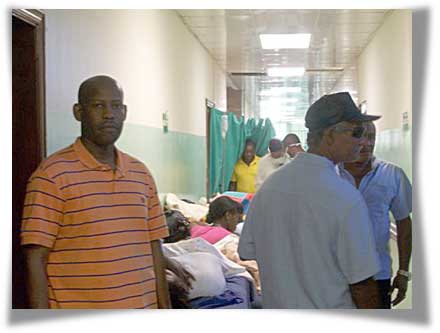
In a hospital in the Dominican Republic, where Francis found his sister.
I arrived at my dad’s damaged house. I hugged him for a while, relieved that he was truly alive and physically okay. The Dominican driver who took me to Haiti insisted that we return to the Dominican Republic the same day. He was very afraid for his life in Haiti.
In the meantime, my dad, who is 73, explained to me how he walked more than six hours in two days to find my sister and take her to the border. After two hours in Haiti I travelled back to the Dominican Republic to get the visa so my sister could travel to the US. Another nine hours of true hell.
I won’t go into details about what it took to get the visa. But after I did get it, the real trouble started. Because my sister was paralyzed she could not travel on a commercial fight. She had to be medevaced to the US, and all the relief flights were leaving from Port-Au-Prince.
We called all the aid/charitable organizations that we knew of, but to no avail. We were told that it would cost between $18,000 and $50,000 for a flight to the US. We did not have any way to raise that much cash in such a short time. Two local TV stations in North Carolina picked up our story. Some people wanted to help with donations, but we did not have an account set up for her. Complete strangers called to offer either prayers or information on how to get a free flight.
I called every number given to me, and my wife and my brothers did the same. But we had no luck. In the meantime, my sister’s condition continued to deteriorate. I made the decision to pay for an ambulance to take my sister back to Haiti. I was praying throughout the whole trip. I was worried that I may have put her in more danger by trying to save her. As we got closer to the border she start having seizures. I was crying and praying to God to save her one more time.
Getting better
We finally made it to the airport. After negotiations, the American soldiers at the airport took her to a big field hospital. She stayed there for another three days waiting for a flight to Florida. Her care improved a bit, but she needed to see a neurosurgeon quickly. She needed more advanced care than what could be provided in a field hospital.
While we were waiting, I helped with translation for the nurses and doctors. I helped turn patients and bagged an eight-year-old child with tetanus. I gave every penny I had to whoever needed it the most. There was so much to be done. Some volunteers worked for 24 hours straight. I slept every night under a tent made of a couple of sheets, hoping it would not rain. I lay on a single sheet, feeling every bump on the ground.
I’m not complaining. I’m just relating the facts. After what I’ve seen I have no right to complain about anything. My fellow Haitians are grateful to be alive and appreciate all the help coming their way. They are struggling to survive and still hopeful for a better tomorrow.
Now that my sister is in Florida she is slowly getting better. She finally had a spinal surgery and was extubated. She is now talking and eating. But she is still very sick due to a stage IV wound infection on her back. She is in a lot of pain and still has no feeling in both her legs. The family is taking turns staying with her in Florida.
We do not have a close family member in the West Palm Beach area. That’s why I’m trying to get my sister to Wake Forest University in Winston-Salem, NC, so she can be close to the family. There is a fund set up in her name. Donations can be made at any Wachovia Bank branch by asking for the First Haitian Wesleyan Church of High Point-Special Fund for Myrtha Almonor. Donations can also be mailed directly to:
First Haitian Wesleyan Church of High Point
724 Old Thomasville Road
High Point, NC
27262
Close story and return to page
Close story and return to page
A Rare Experience
—Frank Caminita, RRT
The initial request for our assistance was made by the University of Miami, which was sending down a team to establish a field hospital near the Port-au-Prince airport. Dräger immediately acted on the opportunity and donated ventilators and anesthesia machines to help equip the hospital.
As my colleague, Robert Dutruch, RRT, and I are no strangers to disaster (we both lived though Hurricane Katrina), both of us and our manager, Dean Calderone, volunteered to make the trip to support this effort. Experiences like this where you can really make a difference in people’s lives don’t come along too often, but they can change a person, and for me, this one did.
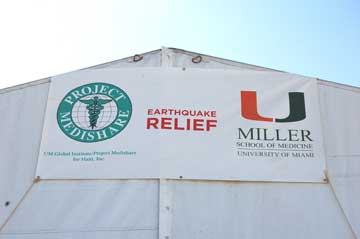
The University of Miami set up a four tent hospital at the airport.
A four-tent hospital
The University of Miami set up a compound consisting of four large tents. The first tent was for the storage of all the donated supplies. Collectively, tents two and three made up the hospital. Tent two housed surgery, the PACU, the ICU, and the adult patients, while tent number three was the pediatric tent and x-ray. The fourth tent housed the sleeping facility used by the field hospital staff. The sleeping arrangement consisted of cots that were basically lined up in rows. The staff quarters were organized on a first come-first served coed basis. We were told to bring enough food and water for the entire length of stay. However, the University of Miami provided several cases of “ready-to-eat meals”, which were greatly appreciated. Staff had to walk down to the nearby United Nations compound for a shower. In total, our team of three spent a week in Haiti.
Prior to leaving, we were in close contact with the University of Miami’s anesthesia staff. Amputations, re-setting broken bones, and all kinds of other surgeries were being performed under either IV sedation or a local nerve block, as there was no general anesthesia available. As soon as the first anesthesia machine was operational we were told they had an 18-month-old baby who needed mechanical ventilation. To make a long story short, we were able to turn the baby around very quickly. I can’t tell you how good it felt to know the difference we were able to make with this first patient. We knew many other patients were yet to come.
Creative thinking pays off
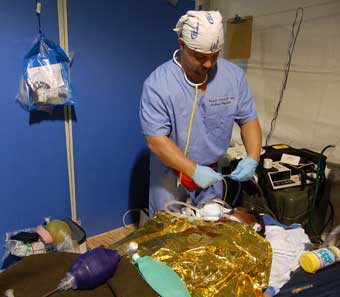
Frank Caminita hard at work on a child.
Our job responsibilities included anything and everything necessary to help, regardless of job title. Duties outside of traditional respiratory care included organizing and creating equipment rooms and establishing a makeshift RT department and pharmacy. I even found myself shooting fluoroscopy at one point. I was also able to have logistics run electricity to the RT department in order to ensure that the Carina ventilators would have a full battery charge when needed.
The last night before coming home, after getting to bed around midnight, I was asked to go back into the PACU around 1:30 AM. A 13-year-old was having difficulty breathing and required intubation and mechanical ventilation. The child was critical, despite 100% FiO2 and 15cmH2O PEEP. Her oxygen saturation initially remained steadfast in the low 80% range. Lung recruitment maneuvers were repeatedly performed and she improved throughout the night.
By morning, I was waiting for a military transport so she could be transferred to the U.S. Navy ship, the Comfort. My biggest concern was transporting her with such high ventilatory requirements. Robert and I improvised a resuscitation bag with a homemade PEEP valve. It wasn’t perfect but it worked! Our patient also developed bronchospasm and required bronchodilators. A syringe was rigged up in such a way that we could give an inhaler directly down the endotracheal tube.
What really matters
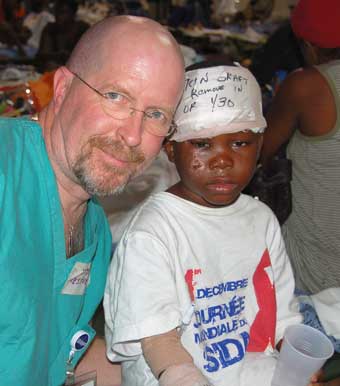
Robert Dutruch spends some time with a young patient.
The Haitian people were so appreciative and happy in a time of tragedy. For me this was emotionally quite moving. I don’t think words can fully describe what it was like to be there—such human compassion and happiness after a crisis of such magnitude. During the second night of our trip, I was awakened from a deep sleep by sounds of singing. I walked over to the pediatric tent, and to my surprise the Haitian people were dancing and rejoicing. It became clear to me how wonderful these people are. They had lost homes, family, children, and limbs, and were suffering greatly, but at the same time they were still able to rejoice in the beauty and gift of life.
After reflecting on my week in the country, what matters most in life has become clearer to me. Happiness is simply a state of mind. Joy in life is based on your perception of where you are, where you have been, and where you are going. After going to Haiti, all of a sudden issues that seemed so enormous just don’t seem that significant anymore.
In summary, keep a positive attitude, realize all the things you have to offer, help others, and live your life with integrity. It is with this attitude and outlook that you will find success and fulfillment.
Close story and return to page
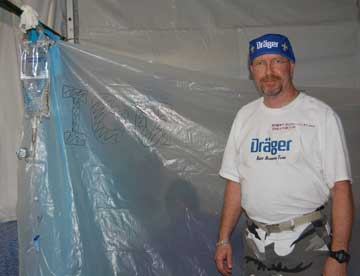
Dutruch stands in front of the ICU.

One of the hospital tents at the airport.

Even in the worst of times, the Haitian people find a way to rejoice.
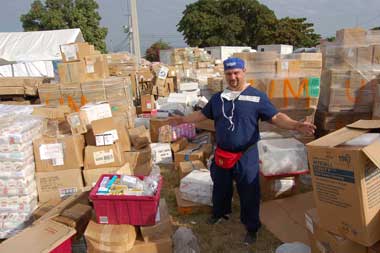
Caminita shows off just some of the donated supplies.
Close story and return to page
Close story and return to page
It Moved Me to Tears
—Bob Stafford, RRT
A day or two after the quake — it was a Sunday — I received an e-mail on my Outlook account at work. The note said the AFT Union was responding to the interests shown by many of its health care members and had hopes of sending medical teams to aid Haiti.
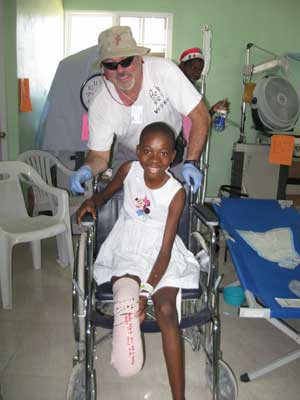
Bob Stafford pushes a young patient through the
compound’s health facility
Since becoming an RRT two years previous, I had hoped to get involved in an organization that provided emergency disaster help. As it turned out I was scheduled to train in the pediatric ICU for the next two weeks; thus I was not included as part of the daily workforce for our respiratory department for the next two weeks. This, and having the necessary CTO (vacation time), opened the door for my manager to allow me to go. I know other RTs here at Fletcher Allen Health Care are interested in going, but at this time I have been the only RT able to go.
Welcomed with open arms
Three days after applying, I was on a plane to Santa Domingo with ten other people: five RNs, a resident trauma surgeon, a third year medical resident, two paramedics, and an EMT. We left from Burlington, VT, on January 20 and returned on February 3.
Packing for this trip was, in a word, challenging. The Vermont Haiti Project and the AFT Union packed three or four large suitcases full of nursing and surgical supplies donated from local health care organizations for our team to bring. In my bag I had some respiratory supplies, my pulse-ox, and the assorted tools a respiratory therapist walks around with daily. What to bring medically was easy — it’s all good. However, what to bring personally was much more difficult. You had to pack light — backpacking was a probable mode of transportation. Water purification systems, assorted medications for diarrhea and malaria, food, water, sleeping bag, protective clothing, sunscreen, and the list just goes on and on.
Our sponsoring agency needed information about relief help being provide in a Haitian/Dominican Republic boarder town called Jimani. I and four other team members hired a local taxi in Santa Domingo to take us to Jimani, a six hour drive. Once there we were able to find the Good Samaritan Compound and the International Medical Alliance organization.
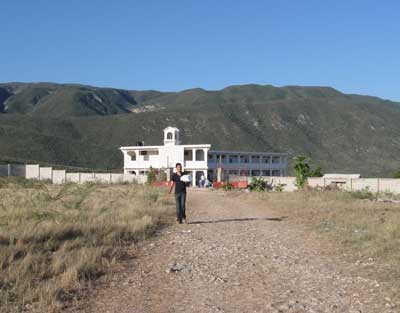
The compound was located on the Haiti/Dominican Republic
border, in a town called Jimani
We walked through the gates and were welcomed with open arms and big smiles by those in charge. And when we told them we had six nurses a day behind us, their smiles grew even larger. A few days before we got there, the patient population was nearing a thousand. When we arrived it was just over 400. The facility had been built years earlier with the intent to provide medical help to the Haitian migrant workers, along with housing for a large medical staff and shelter and housing for the children and families of the people seeking work in this neighboring country.
Perhaps a total of 100 or 150 people could be accommodated. Currently it was being asked to house and provide health care for 400-plus patients and their family members. Thus the infrastructure of the facility was overtaxed. Sleeping on mattresses laid on the floors was the norm for both the patients and the medical staff. Toilets were stressed, water supplies were low, and meals consisted of beans and rice. However, no one was hungry, no one was thirsty, and everyone slept with some comfort.
Just what they needed
Our team make-up was just what this place needed. A superior trauma surgeon, an extremely gifted and dedicated third year resident with med/surg experience, three young, eager, and intelligent emergency techs who took over external transport of patients, and what was needed most — nurses.
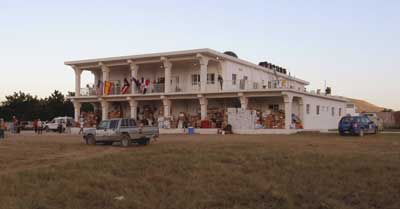
Stafford and his team were assigned to this compound during
their stay in the country
Most patients had traumatic crush wounds and broken and amputated limbs. Since we had no x-ray, most wounds were externally fixed. There were not a whole lot of respiratory issues — at least not yet. The pneumonia, sepsis, and respiratory health issues were just starting to appear about the time I was leaving.
I did take over maintaining the O2 supply tanks for the ORs, gave the occasional nebulizer treatment, bagged, and assisted during a procedure when an endotracheal tube was fashioned into a chest tube by a surgeon and inserted to relieve a horrible case of emphysema.
While my respiratory skills and knowledge were not in constant need, I found what was needed was for someone to head up the internal transport of patients to and from the OR and the outlying buildings where the patients were housed. Procedures, daily cleansing of wounds, and the checking of the external fixes entailed moving 40 to 50 patients a day. Transporting the patients, their belongings, and family members via an older but still serviceable ambulance 12 to 14 hours a day was tiring work. However when you saw the big smiles, the pain the patients would endure, and the effort they would make to make moving them easier, your own aches and pains went away.
Thank goodness for wrap-around glasses

A Blackhawk helicopter flew in and out of the area, transporting
patients to the USS Comfort hospital ship
At 6'1" and 230 lbs, I look rather silly crying, but this experience brought me to tears. First off, it was all striking, interesting, and heartbreaking. The docs and medical personnel I worked with from around the world — who left their egos at home and came to help — were amazing. The quick bonding that took place amongst us was formidable. Docs, nurses, and others would seek me out to say goodbye — we appreciated each other so much. I know if I’m ever in Orange County, CA, I’ll be in good hands.
Carrying a stretcher out to the Blackhawk helicopter with two four-year-old children on it who were to be flown to the USS Comfort hospital ship was something I’ll never forget. I don’t know who was in more awe, them or me. But when I teared up the most was when the docs and nurses gathered and sang “Happy Birthday” to a young boy of 12 who had recently had both legs amputated below the knee. He was smiling the biggest smile and clapped when we finished. I started off singing rather loudly, but halfway through my voice went away and the tears just flowed out. Thank goodness I had my wrap-around sunglasses on to collect the tears.
I would do it again
My trip to Haiti was just one of many that has taken place since the earthquake. What Haiti needs the most right now is a sustained effort of medical help, and the Vermont Haiti Project and the Vermont Federation of Nurses and Health Professionals is helping to provide it. I think we are up to Team 5 or maybe 6 now. Each team does an average of two weeks of relief work at the Jimani compound and/or the Fond Parisian refugee site.
Through continued fundraising efforts by the Vermont Haiti Project teams will continue to go down for the foreseeable future. Please consider donating to this group to maintain their worthwhile efforts in helping the Haitian people. I and the other health care professionals donated our time and were forced to use vacation time in order to provide this much needed help. Your donation will go directly to help provide transportation of our dedicated teams to where they are needed most.
Would I go again? The answer is yes, I would definitely like to go back. Just as soon as I can save up the vacation time.
|
